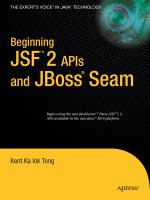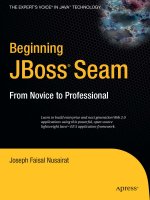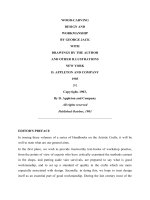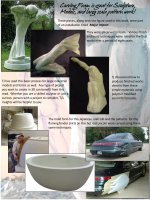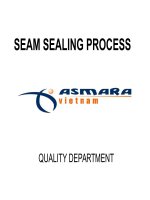Ch07 seam carving
Bạn đang xem bản rút gọn của tài liệu. Xem và tải ngay bản đầy đủ của tài liệu tại đây (6.83 MB, 50 trang )
Chapter 7 – Seam Carving
7-1
Chapter 7
Seam Carving
Michael Rubinstein, MIT
Shai Avidan, Mitsubishi Electric Research Labs
Ariel Shamir, The Interdisciplinary Center & MERL
Department of Mechatronics
Chapter 7 – Seam Carving
7-2
Contents
Image resizing
• Seam Carving algorithm
Department of Mechatronics
Chapter 7 – Seam Carving
7-3
Display Devices
Department of Mechatronics
Chapter 7 – Seam Carving
7-4
Content Retargeting
PC
Department of Mechatronics
iPhone
Chapter 7 – Seam Carving
7-5
Page Layout
Department of Mechatronics
Chapter 7 – Seam Carving
7-6
Simple Media Retargeting Operators
Letterboxing
Scaling
?
Department of Mechatronics
?
Chapter 7 – Seam Carving
7-7
Content-aware Retargeting Operators
“Important”
content
Contentaware
Contentoblivious
Department of Mechatronics
Chapter 7 – Seam Carving
7-8
Content-aware Retargeting
Scale
Input
Department of Mechatronics
“less-Important”
content
Crop
Content-aware
Chapter 7 – Seam Carving
7-9
Image Retargeting
• Problem statement:
• Input Image I with size n × m, and new size n’ × m’
• Output Image 𝑰𝑰𝑰 of size n’ × m’ which will be “good
representative” of the original image I
• To date, no agreed definition, or measure, as to what a
good representative is in this context!
Department of Mechatronics
Chapter 7 – Seam Carving
7-10
Image/Video Retargeting
• In large, we would expect:
1. Adhere to the geometric constraints (display/aspect ratio)
2. Preserve the important content and structures
3. Limit artifacts
4. Perhaps a new representation that will support different
sizes?
• Very ill-posed!
o How do we define important? Is there a universal ground
truth?
o Would different viewers think the same about a retargeted
image?
o What about artistic impression in the original content?
Department of Mechatronics
Chapter 7 – Seam Carving
7-11
Importance (Saliency) Measures
• A function S: p [0,1]
Wang et al. 2008
• More sophisticated: attention models, eye tracking (gazing
studies), face detectors, …
Judd et al. ICCV09 Learning to predict where people look
Department of Mechatronics
Chapter 7 – Seam Carving
7-12
General Retargeting Framework
1. Define an energy function E(I)
(interest, importance, saliency)
2. Use some operator(s)
to change the image I
Recompose
Crop
Setlur et al.
[2005]
Santella
et al.
[2005]
Gal et al.
[2006]
Department of Mechatronics
Warp
Chapter 7 – Seam Carving
7-13
Previous Retargeting Approaches
• Optimal Cropping Window
• For videos: “Pan and scan”
Still done manually in the movie industry
Liu and Gleicher, Video Retargeting: Automating Pan and Scan (2006)
Department of Mechatronics
Chapter 7 – Seam Carving
7-14
Cropping
Department of Mechatronics
Chapter 7 Seam Carving
7-15
Seam Carving
ã Assume m ì n m ì n, n < n
ã Basic Idea: remove unimportant pixels from the image
o Unimportant = pixels with less “energy”
• Intuition for gradient-based energy:
o Preserve strong contours
o Human vision more sensitive to edges – so try remove content
from smoother areas
o Simple, enough for producing some nice results
o See their paper for more measures they have used
Department of Mechatronics
Chapter 7 – Seam Carving
7-16
Pixel Removal
Optimal
Department of Mechatronics
Least-energy pixels Least-energy columns
(per row)
Chapter 7 – Seam Carving
7-17
A Seam
• A connected path of pixels from top to bottom (or left to right).
Exactly one in each row
Department of Mechatronics
Chapter 7 – Seam Carving
7-18
Seams in Images
Efros & Freeman [2001] – Texture synthesis
Kwatra et al. [2003] – Image and video synthesis
Agarwala et al. [2004] – Digital Photomontage
Mostly
used Image
for composition
of
Perez et al. [2003]
– Poisson
Editing
Jia et al. [2006]
– Drag-and-Drop
Pasting
two
(or more) images
or patches…
Rother et al. [2006] – Auto-Collage
Wang and Cohen [2006] – simultaneous matting and
compositing
Agarwala et al., Interactive Digital Photomontage
Department of Mechatronics
Chapter 7 – Seam Carving
7-19
Finding the Seam?
Department of Mechatronics
Chapter 7 – Seam Carving
7-20
The Optimal Seam
E (I ) =| ∂ I | + | ∂ I |
∂y
∂x
Department of Mechatronics
s * = arg min E ( s )
S
Chapter 7 – Seam Carving
7-21
The Optimal Seam
• The recursion relation
M(i, j )= E (i, j ) + min(M(i − 1, j − 1), M(i − 1, j ), M(i − 1, j + 1) )
• Can be solved efficiently using dynamic programming
in O ( s ⋅ n ⋅ m)
(s=3 in the original algorithm)
Department of Mechatronics
Chapter 7 – Seam Carving
7-22
Dynamic Programming
• Invariant property:
o M(i,j) = minimal cost of a seam going through (i,j) (satisfying
the seam properties)
Department of Mechatronics
5
8
12
3
9
2
3
9
7
3
4
2
4
5
7
8
Chapter 7 – Seam Carving
7-23
Dynamic Programming
M(i, j )= E (i, j ) + min(M(i − 1, j − 1), M(i − 1, j ), M(i − 1, j + 1) )
Department of Mechatronics
5
8
12
3
9
2+5
3
9
7
3
4
2
4
5
7
8
Chapter 7 – Seam Carving
7-24
Dynamic Programming
M(i, j )= E (i, j ) + min(M(i − 1, j − 1), M(i − 1, j ), M(i − 1, j + 1) )
Department of Mechatronics
5
8
12
3
9
7
3+3
9
7
3
4
2
4
5
7
8
Chapter 7 – Seam Carving
7-25
Dynamic Programming
M(i, j )= E (i, j ) + min(M(i − 1, j − 1), M(i − 1, j ), M(i − 1, j + 1) )
Department of Mechatronics
5
8
12
3
9
7
6
12
14
9
10
8
14
14
15 8+8
